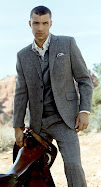Wearing suits began at roughly the beginning of the Industrial Revolution, at the end of the eighteenth century. At that time the British Isles dominated the world in the production of wool. Wool comes from sheep. The first step is called "carding," where the wool is scraped together into long strands. There are two basic types of wool: woollen and worsted.
- WOOLEN: This type of wood is coarse and heavy. Carding is all that is done to refine the wool. The result is used for sweaters, tweek, flannel, and meltons.
- WORSTED: After its been carded it is combed to make the fibers more parallel with fewer exposed ends, resulting in smoother strands. These strands are then tightly twisted to make very long, fine strands.

This raises the issue of the term "Super" as in "Super 120's." The first usage of this term came from the Ermenegildo Zegna factory in the northern Italy village of Trivero. The introduced the term "Super 80's" denoting that their wool was 18 micron's in diameter. The number refers to the diameter of the wool, not the thread count. The higher the number advertised, the finer the wool, although it is a marketing term, not an actual measurement.
Regardless of the Super count, there are 3 types of worsted wool that are typically used in suits.
- Merino: It's a type of sheep. Wool from merino sheep create the softest, most expensive wool for suits.
- Cashmere: This is an even finer hair, from Himalayan goats.
- Angora: From Angora goats, in Turkey

Wool is dyed before it is woven, thus the phrase "dyed in the wool." This results in a more consistent and permanent dye (as opposed to dying the wool after it's been woven into fabric. Patterns are then created from weaving wool yarns of different colors and textures.
- Hopsack: a course, loose weave
- Flannel: a loose term for any fabric with a smooth, napped surface
- Twill: a weave that makes a diagonal line
- Gabardine: made from a tight twill weave
- Houndstooth: a twill variation, made of jagged, broken checks
- Herringbone: made by alternating the direction of two twill patterns to make a 'V' pattern
- Glenplaid: a pattern of small checks alternating with large squares
- Windowpane: large, plain, open square pattern
- Pinstripe: solid wool with a fine stripe of a contrasting color
- Chalk stripe: Like a pinstripe, but with a less sharply defined line that may be faintly blurred or indistinct.
Wool suits are here to stay. Hopefully this little taste of wool education will help you better understand and appreciate the suits you enjoy so much.










